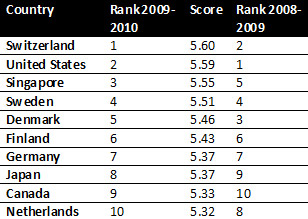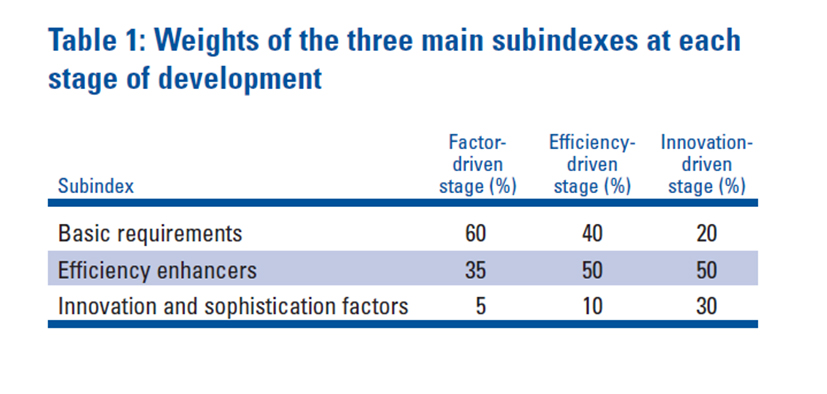By: Rob Blaauboer
The Dutch Innovation Platform, a think-tank established by the Dutch Government, recently released a report Nederland 2020, Back in the top 5 outlining the steps the Netherlands needs to take to regain its former position in the top 5 of the World Economic Forum’s Global Competitiveness Index (GCI). In this article Rob Blaaboer, contributing editor from the Netherlands, suggests a way to reach the New Dutch economy, i.e. innovative, international and involving, and how to get back in the top 5.
The Innovation Platform offers four recommendations for the Netherlands to get back in the top 5: Focus, Internationalization, Entrepreneurship and Service Innovation.
Focus
Focus refers to the need for the Netherlands to focus on areas where it excels: High Tech Systems and Materials, Flowers and Food, Water, Chemicals and Creative Industry. By focusing on a few key areas we can reduce the fragmentation of funds. At least 50% of government spending on innovation programmes should go to these key areas with the promise of long term commitment from government. This list of key areas can be added to or reduced to meet future needs.
Internationalization
Internationalization refers to the need to attract more international companies to the Netherlands – companies that are aligned to our strengths and key research areas. The goal is to attract 100 large corporations to establish their headquarters in the Netherlands through better branding and attraction of foreign talent.
Entrepreneurship
A strong entrepreneurial culture is the third requirement. Entrepreneurs should be regarded as good examples, and not as foolish people giving up the certainty of a steady income. More companies and startups should be supported through the phases of expansion and development, to become international players. This requires that entrepreneurship be embedded in (secondary and tertiary) education. The bureaucracy surrounding the establishment of new business should be reduced and tax exemptions for startups and fast growers would help these new small companies to hire staff. They also need easy access to finance (grant, funding, venture capital, credit)
Service Innovation
Service innovation is related to the services sector. A growing services sector aligned to manufacturing in key areas and as an industry sector in its own right will help to increase exports. Cooperation between education and business will strengthen the knowledge infrastructure.
According to the Innovation Platform, these recommendations are supported, and even reinforced, by four additional requirements:
- Excellence in education and the knowledge infrastructure
- A flexible job market in which all participate
- Superior infrastructure (energy, roads, public transport)
- Government that stimulates and facilitates growth
Each of these requirements is an additional challenge, and each has been the subject of in depth research. The problems addressed are fundamental and not easy to change.
This does however demand or even require a different way of reaching the goals, namely to innovate our innovation policies!
Change encounters resistance
In the Netherlands there are many opportunities to object to the construction of new roads, off shore wind farms and industry parks for instance. Activists are able, in some cases, to halt developments for many years. In light of the recent financial crisis, new legislation (Crisis en Herstel Wet) has been introduced to speed up large infrastructure developments deemed to be of national importance.
Since the 9th June elections, Excellence in Education has become a major issue. We must wait to see when a government is formed how much investment will go to education. Although all political parties support the provision of more money for education, the challenges related to education are large and the goal of having excellent teachers in all classrooms seems a long way off based on the information that people undergoing teacher training are failing (reasonably simple) maths and grammar tests.
The outcome of the elections and formation of a new Dutch government will influence the direction and amount of spending. Depending on the eventual coalition (left, centre, right or a combination) some of the recommendations will get more or less money and attention.
Innovating our innovation policies
Let me start by saying that there is no magic formula that will guarantee a return to the Top 5. It is too easy (but true) to say it will require blood, toil, tears and sweat. Innovation involves a great deal of hard work.
Government is like most large companies: set in its ways and difficult to change. I believe that an entirely new approach is needed, a different operating model, akin to the open innovation model. Stakeholders need to work together towards a common goal based on shared interests. They will need time to find ways to cooperate. The future Ministry of Innovation should be based on civil servants and stakeholder representatives working together with the aim of equal representation. The stakeholders are (in addition to government): industry, schools and universities and, ultimately, of course citizens.
A new ministry of innovation model
We can make a number of recommendations to change the current approach:
- demonstrate the importance of innovation by appointing a minister of innovation with equivalent powers to ministers of other core departments such as Economic Affairs, Justice);
- Establish an operating model based on open innovation rather than a traditional ministry, and have a mixture of civil servants and representatives of companies, universities, schools and other stakeholder communities;
- Aim for rejuvenation in the Ministry of Innovation. Avoid the usual suspects and aim for the mid career talent pool combining people who know how it works with those with stamina and drive to make it work (less politics and political power-play);
- create an atmosphere of change in which failure is not an option.
All of this will be required for the Netherlands to take its place in the Top 5. These recommendations should be seen as starting principles that can be updated based on new insights and progress and after careful consideration.
Being too ambitious?
Is regaining our position in the top 5 too ambitious an objective for the Netherlands? It could be argued that regaining our position makes sense. However, this would be to ignore the changes that have occurred across the world and the new emerging economic superpowers such as China and India.
But this is also not to say that it is an impossible goal. I believe this goal to be not unattainable, for the following reasons:
- we are not trying to become number 1 in the GCI);
- we are currently in 10th position (2 positions down from 2009), but the goal of reaching number 5 is still realistic.
The Innovation Platform report on the competitiveness of the Netherlands is not the only report to call for improved innovation. The Europe 2020 report published by the EC is the successor to the Lisbon strategy. Its subtitle is: A strategy for smart, sustainable and inclusive growth. It calls for European member states to translate the European goals set out in the report into strategies for their own countries.
Recent speeches and articles by the US Secretary of Commerce Gary Locke and Google CEO Eric Schmidt have voiced America’s fears of losing out as the world’s greatest innovator, to countries such as China and India, and also Germany. We might improve our ‘game’, but if others also improve the Netherlands we might end up in the same position or even lower.
By innovation our innovation policies: a ministry of innovation with a private public operating model and a determination to make it work (combined with ‘failure is not an option’) could be the first step to move the Netherlands back in the top 5. The above recommendations are starting principles that should be updated based on new insights and progress.
The recommendations are unorthodox and will not be easy to implement which is in line with their goals which are also difficult to achieve.
The World Economic Forum’s Global Competitiveness Index (GCI)
The World Economic Forum defines competitiveness as the set of institutions, policies and factors that determine the level of productivity of a country.

The GCI competitiveness report lists the top 10 countries, and changes in the rankings. It discusses countries not included in the top 10 based on their importance in the world.
Composition of the Index
The GCI covers three main areas (Basic Requirements, Efficiency Enhancers, and Innovation and Sophistication) among a total of 12 factors against which competitiveness is measured. There are a number of measurable ‘hard’ data indicators (e.g. broadband internet subscribers, infant mortality, HIV incidence) and a number of ‘soft’data indicators which are taken from the Executive Opinion Survey.

The weightings of these factors depend on the stage of development of the country. The Netherlands and most of Europe (with the exception of newl EU member states) are in the innovation driven stage.
The recommendations/measures proposed by the Innovation Platform will have an impact on the GCI index. The items not covered by the index are of less interest.

By Rob Blaaboer, contributing editor, the Netherlands
About the author
 Rob has more than 13 years of innovation experience and he is currently the Innovation Practice Manager at Logica, responsible for, among others, participation in research projects (like FP7 and national programmes). Furthermore, he manages Logica’s contribution to the Norm for Innovation Management (TC 389) and is part of Logica’s Global Innovation Council. In the past, Rob has worked as Interim Innovation Manager, Global Funnel Manager, Innovation Thought Leader and a number of other innovation positions both internally as well as for clients. He also has extensive experience in Financial Services. Apart from the contribution to this website, he also blogs frequently (in Dutch) on Frankwatching.com on innovation, trends and gadgets.
Rob has more than 13 years of innovation experience and he is currently the Innovation Practice Manager at Logica, responsible for, among others, participation in research projects (like FP7 and national programmes). Furthermore, he manages Logica’s contribution to the Norm for Innovation Management (TC 389) and is part of Logica’s Global Innovation Council. In the past, Rob has worked as Interim Innovation Manager, Global Funnel Manager, Innovation Thought Leader and a number of other innovation positions both internally as well as for clients. He also has extensive experience in Financial Services. Apart from the contribution to this website, he also blogs frequently (in Dutch) on Frankwatching.com on innovation, trends and gadgets.
